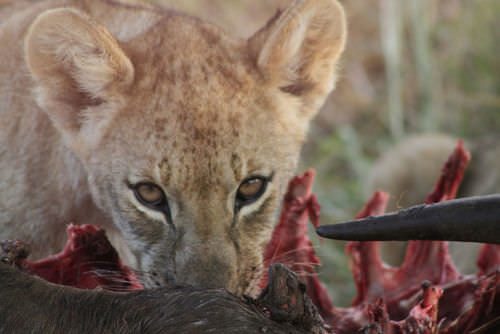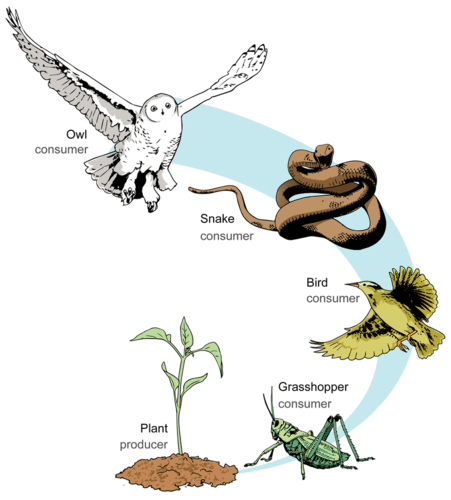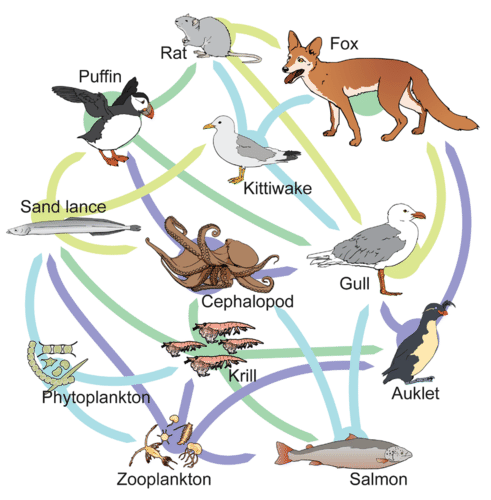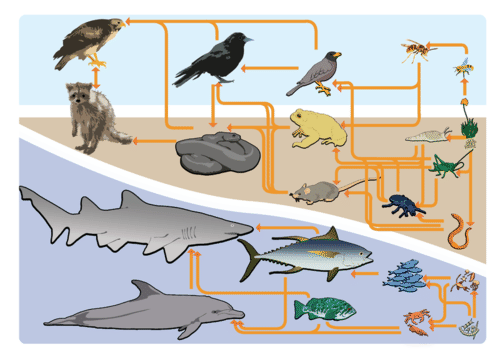6.24: Cadena Alimentaria
- Page ID
- 107954
\( \newcommand{\vecs}[1]{\overset { \scriptstyle \rightharpoonup} {\mathbf{#1}} } \)
\( \newcommand{\vecd}[1]{\overset{-\!-\!\rightharpoonup}{\vphantom{a}\smash {#1}}} \)
\( \newcommand{\dsum}{\displaystyle\sum\limits} \)
\( \newcommand{\dint}{\displaystyle\int\limits} \)
\( \newcommand{\dlim}{\displaystyle\lim\limits} \)
\( \newcommand{\id}{\mathrm{id}}\) \( \newcommand{\Span}{\mathrm{span}}\)
( \newcommand{\kernel}{\mathrm{null}\,}\) \( \newcommand{\range}{\mathrm{range}\,}\)
\( \newcommand{\RealPart}{\mathrm{Re}}\) \( \newcommand{\ImaginaryPart}{\mathrm{Im}}\)
\( \newcommand{\Argument}{\mathrm{Arg}}\) \( \newcommand{\norm}[1]{\| #1 \|}\)
\( \newcommand{\inner}[2]{\langle #1, #2 \rangle}\)
\( \newcommand{\Span}{\mathrm{span}}\)
\( \newcommand{\id}{\mathrm{id}}\)
\( \newcommand{\Span}{\mathrm{span}}\)
\( \newcommand{\kernel}{\mathrm{null}\,}\)
\( \newcommand{\range}{\mathrm{range}\,}\)
\( \newcommand{\RealPart}{\mathrm{Re}}\)
\( \newcommand{\ImaginaryPart}{\mathrm{Im}}\)
\( \newcommand{\Argument}{\mathrm{Arg}}\)
\( \newcommand{\norm}[1]{\| #1 \|}\)
\( \newcommand{\inner}[2]{\langle #1, #2 \rangle}\)
\( \newcommand{\Span}{\mathrm{span}}\) \( \newcommand{\AA}{\unicode[.8,0]{x212B}}\)
\( \newcommand{\vectorA}[1]{\vec{#1}} % arrow\)
\( \newcommand{\vectorAt}[1]{\vec{\text{#1}}} % arrow\)
\( \newcommand{\vectorB}[1]{\overset { \scriptstyle \rightharpoonup} {\mathbf{#1}} } \)
\( \newcommand{\vectorC}[1]{\textbf{#1}} \)
\( \newcommand{\vectorD}[1]{\overrightarrow{#1}} \)
\( \newcommand{\vectorDt}[1]{\overrightarrow{\text{#1}}} \)
\( \newcommand{\vectE}[1]{\overset{-\!-\!\rightharpoonup}{\vphantom{a}\smash{\mathbf {#1}}}} \)
\( \newcommand{\vecs}[1]{\overset { \scriptstyle \rightharpoonup} {\mathbf{#1}} } \)
\( \newcommand{\vecd}[1]{\overset{-\!-\!\rightharpoonup}{\vphantom{a}\smash {#1}}} \)
\(\newcommand{\avec}{\mathbf a}\) \(\newcommand{\bvec}{\mathbf b}\) \(\newcommand{\cvec}{\mathbf c}\) \(\newcommand{\dvec}{\mathbf d}\) \(\newcommand{\dtil}{\widetilde{\mathbf d}}\) \(\newcommand{\evec}{\mathbf e}\) \(\newcommand{\fvec}{\mathbf f}\) \(\newcommand{\nvec}{\mathbf n}\) \(\newcommand{\pvec}{\mathbf p}\) \(\newcommand{\qvec}{\mathbf q}\) \(\newcommand{\svec}{\mathbf s}\) \(\newcommand{\tvec}{\mathbf t}\) \(\newcommand{\uvec}{\mathbf u}\) \(\newcommand{\vvec}{\mathbf v}\) \(\newcommand{\wvec}{\mathbf w}\) \(\newcommand{\xvec}{\mathbf x}\) \(\newcommand{\yvec}{\mathbf y}\) \(\newcommand{\zvec}{\mathbf z}\) \(\newcommand{\rvec}{\mathbf r}\) \(\newcommand{\mvec}{\mathbf m}\) \(\newcommand{\zerovec}{\mathbf 0}\) \(\newcommand{\onevec}{\mathbf 1}\) \(\newcommand{\real}{\mathbb R}\) \(\newcommand{\twovec}[2]{\left[\begin{array}{r}#1 \\ #2 \end{array}\right]}\) \(\newcommand{\ctwovec}[2]{\left[\begin{array}{c}#1 \\ #2 \end{array}\right]}\) \(\newcommand{\threevec}[3]{\left[\begin{array}{r}#1 \\ #2 \\ #3 \end{array}\right]}\) \(\newcommand{\cthreevec}[3]{\left[\begin{array}{c}#1 \\ #2 \\ #3 \end{array}\right]}\) \(\newcommand{\fourvec}[4]{\left[\begin{array}{r}#1 \\ #2 \\ #3 \\ #4 \end{array}\right]}\) \(\newcommand{\cfourvec}[4]{\left[\begin{array}{c}#1 \\ #2 \\ #3 \\ #4 \end{array}\right]}\) \(\newcommand{\fivevec}[5]{\left[\begin{array}{r}#1 \\ #2 \\ #3 \\ #4 \\ #5 \\ \end{array}\right]}\) \(\newcommand{\cfivevec}[5]{\left[\begin{array}{c}#1 \\ #2 \\ #3 \\ #4 \\ #5 \\ \end{array}\right]}\) \(\newcommand{\mattwo}[4]{\left[\begin{array}{rr}#1 \amp #2 \\ #3 \amp #4 \\ \end{array}\right]}\) \(\newcommand{\laspan}[1]{\text{Span}\{#1\}}\) \(\newcommand{\bcal}{\cal B}\) \(\newcommand{\ccal}{\cal C}\) \(\newcommand{\scal}{\cal S}\) \(\newcommand{\wcal}{\cal W}\) \(\newcommand{\ecal}{\cal E}\) \(\newcommand{\coords}[2]{\left\{#1\right\}_{#2}}\) \(\newcommand{\gray}[1]{\color{gray}{#1}}\) \(\newcommand{\lgray}[1]{\color{lightgray}{#1}}\) \(\newcommand{\rank}{\operatorname{rank}}\) \(\newcommand{\row}{\text{Row}}\) \(\newcommand{\col}{\text{Col}}\) \(\renewcommand{\row}{\text{Row}}\) \(\newcommand{\nul}{\text{Nul}}\) \(\newcommand{\var}{\text{Var}}\) \(\newcommand{\corr}{\text{corr}}\) \(\newcommand{\len}[1]{\left|#1\right|}\) \(\newcommand{\bbar}{\overline{\bvec}}\) \(\newcommand{\bhat}{\widehat{\bvec}}\) \(\newcommand{\bperp}{\bvec^\perp}\) \(\newcommand{\xhat}{\widehat{\xvec}}\) \(\newcommand{\vhat}{\widehat{\vvec}}\) \(\newcommand{\uhat}{\widehat{\uvec}}\) \(\newcommand{\what}{\widehat{\wvec}}\) \(\newcommand{\Sighat}{\widehat{\Sigma}}\) \(\newcommand{\lt}{<}\) \(\newcommand{\gt}{>}\) \(\newcommand{\amp}{&}\) \(\definecolor{fillinmathshade}{gray}{0.9}\)
¿Quién come a quién?
Describir el flujo de energía dentro de un ecosistema responde esencialmente a esta pregunta. Para sobrevivir hay que comer. ¿Por qué? Para obtener energía. Las cadenas y redes alimentarias describen la transferencia de energía dentro de un ecosistema, de un organismo a otro. Es decir, muestran quién come a quién.
Cadenas Alimentarias y Telas Alimentarias
Las cadenas alimentarias y las redes alimentarias son diagramas que representan las relaciones alimentarias. Esencialmente, muestran quién come a quién. De esta manera, modelan cómo la energía y la materia se mueven a través de los ecosistemas.
Cadenas Alimentarias
Una cadena alimentaria representa un único camino por el cual la energía y la materia fluyen a través de un ecosistema. Un ejemplo se muestra en la Figura a continuación. Las cadenas alimentarias son generalmente más simples que lo que realmente sucede en la naturaleza. La mayoría de los organismos consumen —y son consumidos por— más de una especie.
 Esta cadena alimentaria incluye productores y consumidores. ¿Cómo podría agregar descompositores a la cadena alimentaria?
Esta cadena alimentaria incluye productores y consumidores. ¿Cómo podría agregar descompositores a la cadena alimentaria? Webs Alimentarias
Una red alimentaria representa múltiples vías por las cuales la energía y la materia fluyen a través de un ecosistema. Incluye muchas cadenas alimentarias que se cruzan. Demuestra que la mayoría de los organismos comen, y son consumidos, por más de una especie. Los ejemplos se muestran en las figuras a continuación.
 Web Alimentaria. Esta red alimentaria consta de varias cadenas alimentarias diferentes. ¿Qué organismos son productores en todas las cadenas alimentarias incluidas en la red alimentaria?
Web Alimentaria. Esta red alimentaria consta de varias cadenas alimentarias diferentes. ¿Qué organismos son productores en todas las cadenas alimentarias incluidas en la red alimentaria?  Ejemplos de redes alimenticias.
Ejemplos de redes alimenticias. Viernes de la Ciencia: ¿Pueden los parques submarinos proteger al coral
Las comunidades coralinas son increíblemente importantes para la vida marina. En este video de Science Friday, los científicos marinos John Bruno y Elizabeth Selig describen los efectos de las Áreas de Protección Marina locales en la preservación del coral.
Resumen
- Las cadenas alimentarias y las redes alimentarias son diagramas que representan las relaciones alimentarias.
- Las cadenas y redes alimentarias modelan cómo la energía y la materia se mueven por los ecosistemas.
Revisar
- ¿Qué es una cadena alimentaria?
- Describir el papel de los descomponedores en las redes alimentarias.
- ¿Por qué una red alimentaria es más realista que una cadena alimentaria?
- Dibujar una cadena alimentaria terrestre que incluya cuatro niveles de alimentación.
| Imagen | Referencia | Atribuciones |
 |
[Figura 1] | Crédito: flowcomm Fuente: https://www.flickr.com/photos/flowcomm/8553119542/in/photostream/ Licencia: CC BY 2.0 |
 |
[Figura 2] | Crédito: Mariana Ruiz Villarreal (LadyOFHats) para Fundación CK-12 Fuente: Fundación CK-12 Licencia: CC BY-NC 3.0 |
 |
[Figura 3] | Crédito: Mariana Ruiz Villarreal (LadyOFHats) para Fundación CK-12 Fuente: Fundación CK-12 Licencia: CC BY-NC 3.0 |
 |
[Figura 4] | Crédito: Mariana Ruiz Villarreal (LadyOFHats) para Fundación CK-12 Fuente: Fundación CK-12 Licencia: CC BY-NC 3.0 |

